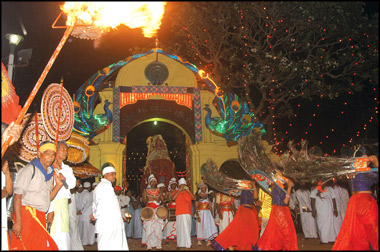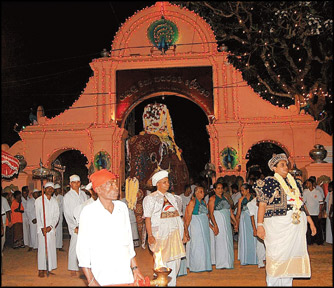The spectacular story of Sikkim
by Padma EDIRISINGHE
No. I have never been to Sikkim. The furthest North I have been in
India in Kashmir and I am rather confused about the actual geographical
position of Sikkim which constitutes the 22nd state of India or Bharatha
Desha.
No. Neither have I been taking statistics of India's states. I simply
came upon this fact in a research book undertaken by one of our monks
i.e. Missaka Kamalasiri Himi of Rajagiriya. The book is on the famous
Thera, S. Mahinda Himi.
After having made two trips to Sikkim he unfolds the childhood of
Tibet. Mahinda Himi, who exhorted the Sinhala race of the early and mid
20th century to a frenzy of nationalism via his books of prose and
verse. If one gets curious as to what energized the young Tibetan monk
who comes from Sikkim to get into a fit of preserving the identity of
the island race, what was happening in Sikkim at the time he left these
snowy Himalayan foothills provides the answer. Sikkim was on its way to
losing her identity under the boots of imperialism and the boy, Pempa
Thendupi Serki Cherin (Mahinda Thera's lay name) was too small to
retaliate. What did he do? Once come over here on a scholarship granted
by king of Sikkim, on the request of his elder brother, he transposed
all his national sentiments on to the Sinhala race. It is a unique story
that one can piece out from that text which the author himself does not
directly convey, perhaps failing to see the connection or deliberately
overlooking it.
 |

The tusker comes out of the Maha Devalaya, with Basnayake Nilame
leading the perahera |
 |
I knew a lot about Mahinda Himi but not much about Sikkim, the actual
state the young boy came from. My own subsequent readings opened a
curtain on a country that strangely carries a strange story nettled in
the fangs of imperialism. It was a Buddhist country inhabited by two
clans, Lepchas and the Bhutias. Life went on with the two clans living
in harmony while drums gonged in temples and echoed around the gorgeous
Himalayan range. The sonorous chants of saffron robed monks added to the
native ethos of the environment.
From the 17th century however had seeped in a new race to India,
first in the form of a trading company i.e, the British East India
Company. Local rulers were in disarray and the foreigners found a vast
hunting ground to fatten their resources. One by one states of India
fell into their hands as the Company got the blessings of the State of
England too. Sikkim was soon to succumb but not rapidly. The clans held
fast to their native bonds and then the imperialists performed their
famous tricks. Hindu Gorkhas from Nepal were brought in large numbers
and dissension set in. A House Divided is an easy prey. Sikkim was
sinking.
Its city, Darjeeling was made into a holiday resort for the
Englishmen. Sikkim's total eclipse as a separate state however came
after India gained her independence. Riots began and Indian armies aided
by the Nepalese quelled the riots that ended with an India-Sikkim
agreement. Sikkim became a protectorate of India but by that time one of
its most brilliant citizens was here in Sri Lanka composing verses for
his books as Nidhase Dahana (mantram of independence) to arouse sleeping
Lankans from their lazy slumbers.
He left Sikkim in a very confused state of its history. Many are
under the belief that Mahinda Himi was an orphan handed over to
Mahabodhi Society to be sent to Ceylon.
But actually he had belonged to a very well - known and affluent
family in Sikkim. His father had headed a large Buddhist temple named
Gutiabasthi Vihara that by its very name implies that it catered to the
two main clans of Sikkim. This temple had been later shifted since its
drums disturbed rituals of a church built in the proximity to cater to
the Westerners come over. His elder brother had been a lecturer at
Calcutta University who after the father's death came back to head a
prestigious school where the son of the king of Sikkim himself had
studied. This son was later to go on to Oxford.
But the clouds were already gathering around the independent boy,
Serkey (Mahinda). He felt which way the winds were blowing.
The identity of Sikkim was at stake. A State decree stipulated that
Buddhism and Tibetan culture should do their exit from the school
curriculum. The king himself had got brainwashed and was under
obligation to the British who has sent his son overseas.
One fine day Serkey (Mahinda) and his brother vanished from the
school headed by the elder brother.
They were brought back. At this time Ven. Ganathiloka the German monk
who was residing at Polgasduwa off Hikkaduwa was on a visit to Sikkim.
Perhaps he was responsible for a Buddhist education on a scholarship
that endowed six rupees for sustenance for a whole year! Ven. Kamalasiri
has reproduced in his book all documents as regards this scholarship
that are still preserved in Sikkim Archives.
But this essay, I intended more as a saga of Sikkim than that of
Mahinda Himi though no one can belittle him or his massive role in our
national resurgence. Sikkim today according to sources is so different
from what it was originally.
The Buddhist Lipta clan is almost non-existent. And the Nepalese
Buddhists come over are today mostly Catholics, Gangtok, the capital is
almost a Christian city.
What happened to the royal dynasty that had held sway in Sikkim for
centuries? No. They were not deported to Vellore as done here. The king
did not stand on a pier singing, 'Ithin Ayobowan, Sikkim mawata garu.'
They stayed on in Sikkim utterly powerless till the one who had
claims to the rights to the throne passed away in 1977 under mysterious
circumstances. Some ascribe it to a motor accident. His father, Thendup
Namgyal, school mate of Mahinda Himi(?) the last reigning monarch of
Sikkim like our Sri Wickrema had even a stranger history.
He had succumbed to the charms of a female American missionary busy
converting local Gusthis and Lepchas and married her. They were allowed
to live in the palace even after the political changes. But after the
crown prince's death things became too unbearable and the whole family
shifted to New York.
There his wife left him for another and the ex-king had died all
alone having succumbed to cancer. The king had another son, who was the
second heir to the throne but he got so disillusioned by all what was
happening that he took to robes and retreated to a hermitage.
Two children born later to the American wife of the king, named Hope
and Paldane are said to still live in America. More strangely they are
said to be strongly resistant to American influences and have found life
mates of Sikkim nationality.
Meanwhile, even the relations of S. Mahinda Himi continues to live in
Kalingphone of Sikkim and continue as fervent Buddhists, some even
taking to robes. It was they who had supplied much information to
Missaka Kamalasiri Thera. Well, truth they say is stronger than fiction.
But how much the beautiful snowy slopes of the Himalayas miss the sacred
gongs of Buddhist Sikkim is only left to guesswork! |

